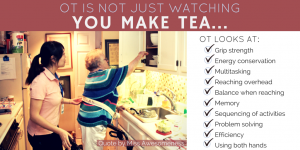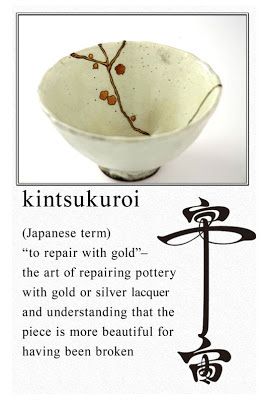Occupational Therapy
For prospective occupational therapy (OT) or current OT students
For prospective occupational therapy (OT) or current OT students:
Sarah wrote this blog post on her OT Potential site about OT school thoughts, for those of you prospective students with questions about OT grad school programs – “Honest Thoughts on OT School and 5 Pieces of Advice for Prospective Students”
Lauren is a current grad school OT student (my grad school posts are in the 2006-2009 archives), and she blogs at https://gottabeot.wordpress.com/
If you are a prospective OT or grad school student OT, feel free to post your blog address in the comments!
Importance of Incorporating Function: The four pound bag of sugar versus gym weight
Short version: We learn a lot by watching a person engage in an “occupation” (a meaningful activity, which can be an activity of daily life such as making tea). And just because a person can do a simple task such as lift a 4 pound weight, doesn’t mean they can lift a 4 pound bag of sugar in their kitchen. See below for long version.
An OT friend, “BJ”, wrote this in an informal forum post, very minimally edited:
“I also do PRN work for a small home health company after school. This setting allows me to incorporate many occupations into treatment sessions. Last week it was as simple as taking my client into her kitchen and trying a light cooking activity, making tea. I was able to assess her ability to reach overhead into her cabinet and retrieve a four-pound bag of sugar while standing.
This activity revealed to me she did not have the grip strength to retrieve the bag with one hand, she had fair balance while standing by the counter, and when reaching over her head into the cabinet she became short of breath. Sometimes in clinical settings [Editor’s note: often due to institution-required-productivity and/or being asked to trea
t too many diverse clients at once], we get set in routines of therapeutic exercises and modalities and lose sight of what the patent’s occupations may be at home.
They may be able to lift a 4 lb bar 20 times, but will they be able to lift a 4 lb bag of sugar out of their cabinet?
“
I loved this reminder. We need occupation and in appropriate context, to truly get a feel for the true functionality of the person. Yes, in a rehabilitation setting, maybe the 80 year-old client can lift that bar, the equivalent poundage of sugar. But at home, is that still true, when now she is dealing with different heights, different angles, different balances, and different sizes? Maybe not.
OTs always love when their clinics do have kitchens so that they can truly work “in situ” for cooking.
Now in this case, based on what the OT just saw, she can work with the client on many different things to help make it easier, although one easy thing is to suggest the client keep her sugar on a shelf that’s easier to access.
I want to note that sometimes it looks as if the OT isn’t “doing anything”, such as watching a client make tea. The OT isn’t doing a “Make tea. I will sit here until she is done. Yep, she did it. Check mark. The End.” The OT is doing what BJ described above – constant functional analysis.
Is the sugar in an appropriate placement? Can the sugar go into a different container?
How can we best work on the client’s grip strength? Let’s look more at her shortness of breath when reaching overhead.
How can we quickly modify her kitchen setup to be more efficient for her? How is her balance in reaching, stooping, turning?
How is her sequencing of activity, her visual attention, her ability to manipulate objects or hold things in both hands? Her problem-solving? Her efficiency? Multi-tasking? Memory?
So you see, we are looking at a TON of different things, including overall physical ability, fine motor skills, cognitive skills, possible helpful modifications/adaptations/accommodations, etc. not just sitting there waiting for a “yes” or “no” as to whether the client can make tea. We just got SO MUCH information about her abilities just by watching the simple task of making tea (and “watching” is only true if the client is independent – often we are providing assistance, either verbally and/or physically).
Updated 12/16/14: Exciting. I wrote this as a self-reflection/explanatory piece, but certainly informally and definitely not expecting a large audience. Wish I had done a nicer job now. Oh well. 🙂 The American Occupational Therapy Association (AOTA) linked this post on their Facebook page and made the infographic shown above! Overnight it’s been shared more than 1300+ times, liked by over 2500, and 130 new followers on my Facebook page for Miss Awesomeness at https://www.facebook.com/missawesomenessdotcom Definitely a nice surprise.
OT lifehack: Great adaptive doorstop
Most doorstops require bending over, which can be a fall or injury risk. Using the equivalent of a stable fire poker as a doorstop allows you to move the doorstop more easily.
Handmade creative clay pencil grips
To make a creative pencil grip, take the ink part out of a pen, roll it into a polymer oven-bake clay and bake it, following directions you can find online for safety [using appropriate clay, not burning your house down or experiencing toxic fumes by baking it too long, etc]. Here’s a tutorial. Here’s another. Those tutorials show a more covered pen, but I think the grip is better off being wound around the pen like in my pictures below. At least the tutorials give you the basics. I haven’t tried it myself. Use your own judgment as to whether it’s a safe and appropriate activity and method.
Occupational Therapists and Kintsukuroi: Repairing with Gold.
As occupational therapists, we often work with those who feel broken. Sometimes I think applying or receiving the lacquer of repair – and seeing the beauty in it – helps us restore our souls.
Quick Tip: Set up "Undo Send" function on Web Gmail
Do you use Web Gmail? Do you sometimes send an e-mail and instantly realize there was a mistake? Do you wish you could undo it? There’s a way!
PATH: *Web browser* gmail > Gear Icon > Settings > Labs > Undo Send > Enable > Save Changes. More details at bottom if you need more help to find it.
Enabled it? Try it.
Write a test email
Hit Send.
Look at the yellow message "Your message has been sent" and next to it the "Undo" link, visible 10 seconds or maybe up to 30(?).
Click that, your mail shows up ready to be modified.
For those split-second realizations where you send it and instantly go OH NO I FORGOT TO INCLUDE THE ATTACHMENT. Undo!!!! Phew. 🙂
=======
If you need help following the path above, here is more detail:
1. Go into web gmail and click on the gear (near the upper right corner).
2. Choose option "Settings" from the drop down menu that appears.
3. Click on the Tab labeled "Labs".
4. Note their warning about beta (experimental) and the work-around if anything goes awry. Don’t worry, it’s simple. And I’ve never had a problem. Also look at other betas – some are awesome!
5. Scroll down and find the "Undo Send" lab. Its description: "Oops, hit "Send" too soon? Stop messages from being sent for a few seconds after hitting the send button."
6. Click the "Enable" button next to it.
7. Scroll down and "Save Changes"
Birthing babies and bills into law: the similar process of fruition
I’m currently writing a short paper on how legislative bills become laws at a state and federal level, as well as how us occupational therapists can advocate/lobby for our profession in the political arena. We’ve been learning how to navigate these processes in our advocacy course in my first semester of my post-professional doctoral program in occupational therapy (we’ll end up with an OTD). Today I realized bills and babies have a lot in common. Here’s a rough-draft of possibly the first paragraph of this paper, we’ll see. Seriously though. Bills and babies. Who knew?
Legislative bills and lovable babies are remarkably similar in the amount of time, complexity, and pain involved in the process of their creation. First, you (ideally) have an idea, then you collaborate with other(s), then you decide to “join forces” in conception, and then you wait to see what happens. After a month or so, you find out if conception was successful. You let everyone know, and spend a lot of time protecting and nourishing this inchoate creation, with regular check-ins to ensure it’s developing as expected by protocol. If anything is awry, you act quickly to handle the concern. If everything is fine, you can just look forward to seeing the final product, but you keep up check-ins just in case. You know all births are different, so you try not to listen to the horror stories of others, but logically you know it is always somewhat painful. Luckily, with support, and barring any complications, it’s bearable, and you know the results are worth it. It’s a labor of love. Right after the birthing process is over, you stare in awe at your little creation. You can’t believe that a year ago, all you had was an idea, and now, you have a reality. Eventually, thanks to all the rewards you reap from your existing creation, you forget how arduous the process was, and you start the process of creation all over again.
Blah blah blah, advocacy advocacy laws bills legislation blah blah blah, gotta keep writing. 🙂
Holidays are approaching. Toys for children with special needs?
http://www.aota.org/~/media/Corporate/Files/Practice/Children/Browse/Play/Toys%20tip%20sheet.ashx
This link is How to Pick a Toy: Checklist for Toy Shopping
This free resource is provided by the American Occupational Therapy Association (AOTA), and it is an awesome way to decide if toys are developmentally appropriate/helpful to the growth of a child. It doesn’t mean not fun, it just means having an eye for what will be beneficial. This is especially true for children with special needs.
Those of you working in clinics, consider printing this out and either posting it on a bulletin board or giving it to parents. Often toy shopping, already stressful, is more so due to there being more limited toy options, depending on the need of the child.
http://www.toysrus.com/shop/index.jsp?categoryId=3261680This is the Toys R Us guide for Differently Abled kids. Apparently this is their 20th year of putting out this list. I am impressed.
Melissa and Doug at http://www.melissaanddoug.com/shop-toys-by-skills also have an entire huge section that divides toys up by what kind of skill they work on – fine motor, auditory, imagination, emotional, etc. Also a great resource.
Most major toy stores should have a toy guide or resources for buying toys for special needs – consider searching their site or writing/calling their Customer Service to ask. And consider shopping locally, the merchants need your business and are often well educated on developmental needs. 🙂
The toy above is from http://www.amazon.com/Fisher-Price-Laugh-Learn-Learning-Piggy/dp/B00CQHYZNS#
It’s one of the all-time favorites of most of my kids and one of the few toys I actually use. It’s seriously addicting, don’t ask me why. I use it for all sorts of silly games. I for sure recommend it.
Upcoming CEU course: Strategies to improve effectiveness of school-based OT!
Next Thursday, November 13th, I’m going up to Anaheim to take a CEU course called "Practical Strategies for Improving the Effectiveness, Efficiency and Impact of Your School‑Based, OCCUPATIONAL THERAPY SERVICES", presented by Beverly Moskowitz. She is also the inventor of the Size Matters handwriting program. She is such a firecracker and I have heard great things about the course. It’s one of the only ones I have ever gotten a brochure on in the snail mail that I actually really wanted to go to. Anybody interested?
If PDF attachment doesn’t show up, the info is at the following link if you want more info on times, locations, etc.
http://www.realotsolutions.com/documents/tour-brochure.pdf
Is it preventative or preventive healthcare?
I had to look it up. The Affordable Care Act says "preventive" and I have always said "preventative".
http://www.quickanddirtytips.com/education/grammar/preventive-versus-preventative
According to Grammar Girl, preventive is preferred by grammar snobs, but both are now considered acceptable.
Now you know, just like me. YAY.
PS: I can NEVER spell Jeapordy right. Ever. I wanted to hum the Jeapordy theme song after the question, but I can’t do it. Jeopardy. There we go. Spelling check can luckily spell it.







